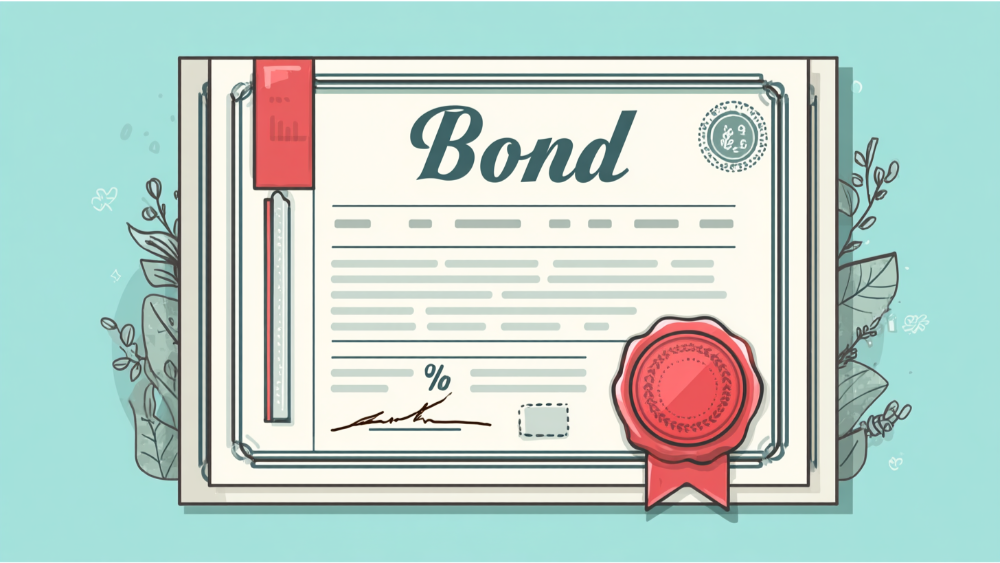In 2025, understanding what is a bond in finance is essential for anyone aiming to build a resilient, income-generating investment portfolio. Bonds are debt securities that allow investors to lend money to entities such as governments, municipalities, or corporations. In exchange, the bond issuer pays interest to the investor and returns the principal amount on a specified maturity date, also called the redemption date. Whether you are managing risk, generating income, or diversifying assets, bonds remain a foundational tool in any wealth management strategy.
The Basics: What Is a Bond in Finance?

A bond is a type of debt instrument. When you purchase a bond, you are essentially lending money to a borrower. The borrower, or bond issuer, could be a corporation, a state or local government, or a federal government. In return, the issuer promises to make regular interest payments and repay the full face value, also known as par value, when the bond reaches its redemption date. These principal payments represent the return of the original amount you invested.
Bond investors are not owners like shareholders. Instead, they are creditors. This relationship comes with certain protections, such as priority in repayment over equity holders in the event of default. Many bonds are structured as non recourse debt, meaning the issuer’s obligation is limited to the bond itself and does not extend to other assets. Bonds are often considered lower-risk investments, especially when issued by entities with a strong credit rating.
Why Entities Issue Bonds
Issuing bonds is one of the most common ways for governments and private entities to raise money. Governments often issue treasury bonds or municipal bonds to fund public infrastructure, balance budgets, or refinance existing debt. Corporations issue corporate bonds to finance expansion, research, or acquisitions.
The bond issuer pays interest to bondholders on a fixed schedule, typically semiannually. The rate paid is influenced by the issuer’s credit rating, the current market interest rates, and the time until maturity or redemption date. The better the credit quality of the issuer, the lower the interest rate they typically need to offer.
Types of Bonds Every Investor Should Know

Understanding the different types of bonds is crucial for effective portfolio construction. Each bond type comes with its own risk profile, tax treatment, and income potential.
Government Bonds
Government bonds are issued by national governments to finance spending and debt. In the U.S., these are called treasury bonds and are backed by the full faith and credit of the federal government. They are considered virtually risk free and are often used as a benchmark for other interest rates. Treasury bonds are issued with varying terms, and their interest payments are exempt from state and local taxes.
Some foreign governments, such as the UK government, also issue debt to fund national projects. These bonds are subject to currency risk for U.S.-based investors.
Municipal Bonds
Municipal bonds are debt securities issued by state and local governments to fund public projects like schools, roads, or water systems. There are two main types of municipal bonds: general obligation bonds and revenue bonds.
General obligation bonds are backed by the full faith and taxing power of the issuing state or local government. Revenue bonds are supported by the income generated from the specific project they finance, such as toll roads or utilities. Many municipal bonds offer interest that is exempt from federal income tax and, in some cases, from state and local taxes as well.
Corporate Bonds
Corporate bonds are issued by companies to borrow money from investors. These bonds can be classified into investment grade bonds, which have higher credit quality, and high yield bonds, which offer higher returns but come with greater credit risk due to a lower credit rating.
Investment grade corporate bonds are favored for their balance of risk and income, while high yield bonds can offer more aggressive returns for those willing to accept more volatility. The bond ratings assigned by agencies like Moody’s Investors Service help investors assess the creditworthiness of these issuers.
Green Bonds
Green bonds are a newer category of bonds issued to fund environmentally sustainable projects. These can be issued by governments, municipalities, or private entities, and they function like other bonds with designated use-of-proceeds toward projects like renewable energy, pollution reduction, or climate change mitigation.
Understanding Bond Components and Pricing

Each bond has several key characteristics that influence its behavior and value in the bond market.
Face Value and Par Value
The face value or par value is the amount the bondholder receives back at the redemption date. Most bonds are issued in increments of $1,000, and the face value is also used to calculate interest payments.
Coupon Rate and Interest Payments
The coupon rate is the annual interest rate paid on the bond’s face value. If a bond has a 5 percent coupon and a $1,000 face value, the issuer pays $50 annually in interest payments, often in two semiannual installments.
Bond Prices and the Secondary Market
Bonds are traded on the secondary market after they are initially sold. The current market price may be above or below par value depending on the bond’s yield relative to current interest rates. When interest rates rise, bond prices typically fall, and vice versa. The value of the bond is therefore influenced by market interest rates, credit conditions, and time to maturity or redemption date.
Yield and Return
Bond yield reflects the return an investor earns based on the bond’s current price. Yield to maturity considers total interest payments and the difference between purchase price and par value over the remaining life of the bond. Investors often monitor yields closely to compare opportunities across various types of bonds.
Key Risks in Bond Investing
While bonds are generally less volatile than stocks, they are not without risks.
Interest Rate Risk
When interest rates rise, newly issued bonds pay more attractive rates, causing existing bond prices to fall. Longer maturity bonds are more sensitive to changes in interest rates.
Credit Risk
Credit risk is the possibility that the bond issuer will fail to make interest payments or repay principal. Issuers with a lower credit rating, such as non-investment grade or junk bonds, are more susceptible to this risk.
Liquidity Risk
Some bonds, especially municipal bonds or high yield issues, may be difficult to sell on the secondary market without affecting their price.
Reinvestment and Call Risk
Investors may face reinvestment risk if interest payments or principal from called bonds must be reinvested at lower rates. Callable bonds give issuers the right to redeem the bond before maturity, often when interest rates fall.
Bond Ratings and Credit Analysis

Bond ratings help investors assess the default risk of different debt securities. Agencies like Moody’s Investors Service assign ratings that range from AAA for highest credit quality to D for default. Investment grade bonds typically have ratings of BBB or higher, while high yield bonds have ratings below that threshold.
Understanding bond ratings is essential for managing credit exposure and building a portfolio that matches your risk tolerance.
Bonds in a Diversified Investment Strategy
Bonds play a vital role in diversified portfolios. They offer steady income, reduce overall portfolio volatility, and help preserve capital. In retirement planning, bonds are used to align income with future liabilities, ensuring that funds are available when needed without having to sell riskier assets during downturns.
Laddering strategies, where bonds are purchased with staggered maturity dates, allow investors to spread out reinvestment over time and mitigate interest rate risk. This approach can be particularly effective in volatile rate environments.
How Bonds Compare to Other Fixed-Income Options
Compared to CDs and money market funds, bonds typically offer higher yields, especially when issued by corporate or municipal entities. While CDs may provide FDIC insurance and a fixed price, their returns are often lower than those of newly issued bonds. Annuities offer guaranteed income but come with complex tax treatment and surrender terms.
Bonds strike a balance between income and flexibility, making them a key part of most income-oriented strategies.
How Towerpoint Wealth Optimizes Bond Portfolios
At Towerpoint Wealth, we view bonds as more than passive investments. We design custom fixed-income portfolios tailored to your income needs, tax preferences, and risk profile. Whether it’s allocating between treasury bonds, municipal bonds, or corporate bonds, or selecting between general obligation bonds and revenue bonds, we ensure each debt security serves a purpose.
We actively monitor bond markets, credit conditions, and interest rate trends to manage exposure and optimize total return. Our fiduciary advisors assess every bond’s issuer, maturity, current price, and tax implications to create a portfolio aligned with your financial objectives.
Frequently Asked Bonds Questions
What is a bond in finance?
A bond is a debt instrument where an investor lends money to a borrower, such as a corporation or government, in exchange for regular interest payments and the return of principal at redemption date.
Why do governments and corporations issue bonds?
They issue bonds to raise money for operations, public infrastructure, or capital expenditures. Issuing bonds helps spread costs over time and avoids giving up equity.
What determines the interest rate on a bond?
The bond’s interest rate is influenced by the issuer’s credit quality, the time to maturity or redemption date, and prevailing market interest rates.
What are the risks of investing in bonds?
Bonds face risks including interest rate risk, credit risk, reinvestment risk, and liquidity risk. Understanding each is crucial to managing a bond portfolio effectively.
How are municipal bonds taxed?
Interest from municipal bonds is usually exempt from federal income tax and may also be free from state and local taxes if issued within your state of residence.
What is the difference between investment grade and high yield bonds?
Investment grade bonds have higher credit ratings and lower default risk. High yield bonds have lower ratings and higher returns but come with greater risk.
Final Thoughts: Why Bonds Still Matter in 2025
In 2025, bonds remain a powerful tool for income, risk management, and capital preservation. Understanding what is a bond in finance means recognizing its role across different market cycles and how it supports long-term financial goals. Whether issued by governments, municipalities, or corporations, bonds provide structure, predictability, and resilience to any investment plan.
At Towerpoint Wealth, we help our clients evaluate all types of bonds, from general obligation and revenue bonds to corporate and green bonds, ensuring each serves a strategic purpose. Let us help you navigate the bond market with clarity, purpose, and confidence.
Ready to integrate bonds into your financial plan? Schedule a consultation with Towerpoint Wealth today.







